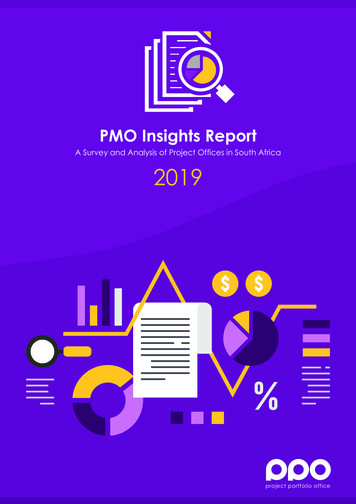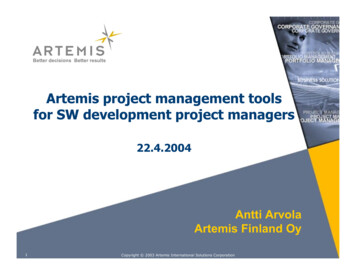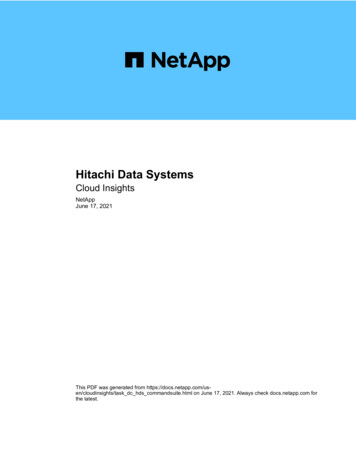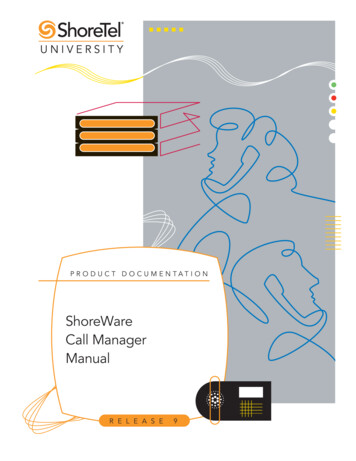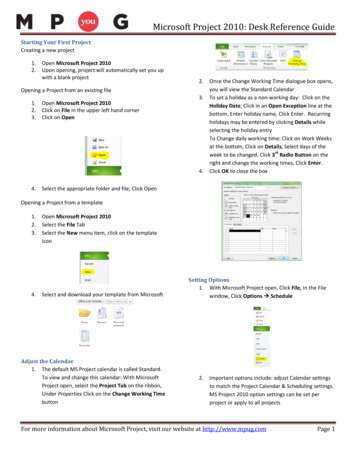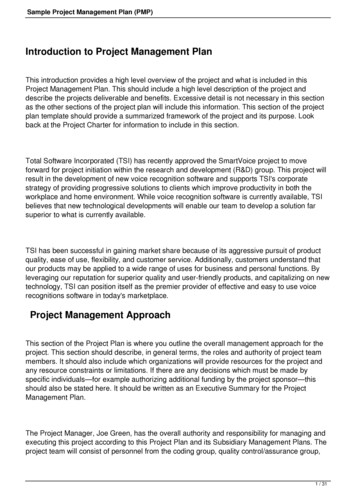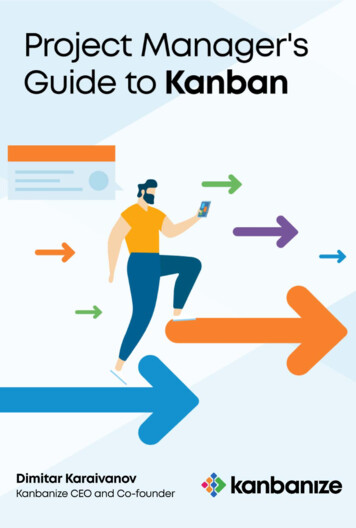
Transcription
Project Manager’sGuide to KanbanWhat’s in it for you?Project Manager’s Guide to Kanban provides valuable insightson Kanban Project Management and will foster your theoreticallearnings with practical examples. It is structured in sixchapters, starting with outlining the basics of Kanban and thebenefits of scaling it from team to management level. Then, itwill explore topics such as Planning, Execution, Tracking andForecasting, Risk Management. In conclusion we will focus onthe overall value and the outcomes that you could expect.As modern Project Management has realised the necessity formore lightweight and efficient techniques, we focus on thebenefits of choosing Kanban. Join the next generation ProjectManagers and help your team minimize waste and increaseefficiency through continuous improvement.Introduction to Kanban forProject Managers with practicalimplementation examples.2 PROJECT MANAGER’S GUIDE TO KANBAN
Preface5Chapter 1. Why Bother with Kanban?7Chapter 2. Why Kanban Project Management with Kanbanize?13Chapter 3. Project Planning21Deterministic vs. Probabilistic Thinking21Planning with Kanban22The Kanban Board as a Planning Tool24Dependencies27Chapter 4. Project Execution29Roles29Prioritization31Sizing and Estimation34Commitment36Blockers & Escalations38Meetings & Feedback Loops41PROJECT MANAGER’S GUIDE TO KANBAN 3
Chapter 5. Project Tracking and ForecastingThe First Principle of Lean - Value4344Cumulative Flow Diagram45Cycle Time Scatterplot Cycle Time Trend46Cycle Time Heatmap48Cycle Time Histogram48Flow Efficiency50Monte Carlo Forecasting51Chapter 6. Managing RiskEliminate WasteWaste #1: ScatterWaste #2: Hand-offsWaste #3: Wishful ThinkingStability & PredictabilityContinuous Improvement (Kaizen)Conclusion4 PROJECT MANAGER’S GUIDE TO KANBAN5456586062636467
PrefaceIn the modern world of globalization, disruptive technologies,and automation, we need to adjust our behavior to handleall this innovation and knowledge efficiently. The new waveof Project Management is not something that we shouldexpect, rather, it is already here. In the quest of processesoptimization, there is a hunger for modern lightweightapproaches that would help Project Managers acquire almostsuperhero characteristics.Well, there is no magic framework that would turn ProjectManagement into a safe playground but we have the remedyfor those who are tired of supporting the “house of cards”.Riding the wave of Kanban Project Management wouldtransform the way this industry looked like a few years ago.And if you think this is a bold statement, let’s go through thefollowing chapters and follow the practical implementationexamples which will shed light on the truly revolutionaryapproach.PROJECT MANAGER’S GUIDE TO KANBAN 5
We have outlined the main principles and practices of Kanban,the benefits it will bring and the difficulties that may ariseduring the implementation. One of the most important aspectsis how to scale a successful practice from a team level to thethe management level and we will explore it in detail. Wewill discuss what needs to change in the Planning, Execution,Tracking and Forecasting, and Managing Risk.There is a better way to manage projects, the Kanban way!If you are ready to apply kanban principles to your work, Irecommend you try Kanbanize free for 30 days.6 PROJECT MANAGER’S GUIDE TO KANBAN
CHAPTER ONEWhy Bother withKanban?Project management has been around for decades, if notcenturies. It flourished throughout the industrial revolutionand became an instrument for the astonishing progresshumanity has achieved.Most of the world around us is the result of many smart peoplemanaging projects and programs. We see it in every building,vehicle, desk, chair, window they were all the result ofprojects well managed (or not that much).However, a lot has changed since the industrial revolution. Thefactories that used to harness human labor are now poweredby robots, infinitely more productive than the human hand.PROJECT MANAGER’S GUIDE TO KANBAN 7
Computers became mainstream, we invented the mobilephones, the internet, AI, machine learning, blockchain andwhat not. If that wasn’t enough, globalization took over andthat completely disrupted the way companies do business.Compared to the 50s, the world has become a much morecomplex place In this new paradigm, the effectiveness of our managementprocesses has continuously degraded. This dissonance createda vacuum that sucked up billions of dollars in failed projects ormissed opportunities. The generated pain and disappointmentultimately led to the creation of new, more effective methodsthat were better suited to operate in an environment ofuncertainty and complexity.In just 20 years, the so-called Agile methods managed todominate the IT and Software Development spaces. We saw thecreation of frameworks such as XP and Scrum that are widelyadopted and are quite the norm for tech teams in most of thecompanies today.Some ten years back, a very important event took place - DavidJ. Anderson published the first book about Kanban (also knownas the blue book). This marked the birth of a strong movementthat led to the existence of the “Kanban method” the way weknow it today.8 CHAPTER ONE WHY BOTHER WITH KANBAN?
The Kanban method is truly remarkable. In less than a decade,it was adopted by more than half of the IT / Software industry.A recent survey (“State of Scrum”) shows that 60% of theScrum teams use Kanban. This data is stunning because onlyseveral years ago, Scrum in its pure form had virtually noalternative.The reason why so many teams and companies are turning toKanban lies in the core principles and practices of the method.The Kanban PrinciplesThere are three guiding principles thatrepresent the Kanban way of thinking:1.Start With What You Do Now»Understanding current processes, as actually practiced»Respecting existing roles, responsibilities & job titles2.Gain agreement to pursue improvement through evolutionarychange3.Encourage Acts of Leadership at All LevelsIf you compare these principles to any other popular approach,you will quickly realize that Kanban is very humane. It doesn’ttell you that there’s a right way of doing things and that youare doing it wrong. On the contrary, it respects the currentsituation and helps you improve from where you are. There isPROJECT MANAGER’S GUIDE TO KANBAN 9
no judgment in Kanban!In that regard, Kanban is a truly Lean method, following theprinciples of continuous improvement and respect for people.The principles we know so well from Toyota.The Kanban PracticesGoing from the philosophy of things (principles) to what wedo on a daily basis, we identify six core practices in Kanban.»Visualize work»Limit Work in Progress»Manage Flow»Make Policies Explicit»Implement Feedback Loops»Improve Collaboratively, Evolve ExperimentallyThe goal of this book is not to explain what Kanban is so wewon’t discuss all the practices individually. However, we willbe providing concrete examples further in the book. One thingis certain - if you use these practices you will be much moreproductive in your daily work, be it management, coding,design, etc.10 CHAPTER ONE WHY BOTHER WITH KANBAN?
If you’re still wondering if Kanban is for you, havea look at the benefits of using the method:»Dramatic improvements of your cycle times realized soon afterstarting out. The improvements usually go way beyond 100%.»Relief from overburdening and happier workforce.»Increased customer satisfaction due to shorterdelivery times and increased predictability.»Compatibility with any process. Kanban improves the flowof value without forcing the organization out of its ways.»Universally applicable - it is not bound for use bythe IT or software development teams only.»Survivability and sustainability of thebusiness, if applied strategically.»Understanding of the work state and project status.»Qualitative and quantitative understanding of the workflow.»Increased predictability and an ability to respond withconfidence to tough questions like “When will you deliver?”,“When should we start a job to deliver by a certain date?”.Do you have issues with one or more of the items above? Ifyes, this book is for you. We aim to provide practical guidancefor Project Managers that are seeking ways to improvetheir workflows without necessarily adding more people orresources.We will show you how to plan your project in an alternativeway and how to connect the planning to the execution. We willalso suggest a scalable way to track one or multiple projectsPROJECT MANAGER’S GUIDE TO KANBAN 11
using hierarchical Kanban boards. On top of that, we willdiscuss forecasting that’s based on the actual data that yougenerate as the project goes. If you’re ready to get started witha kanban tool, you can try Kanbanize free for 30 days.It will be quite a ride, we hope you’ll enjoy it!12 CHAPTER ONE WHY BOTHER WITH KANBAN?
CHAPTER TWOWhy Kanban ProjectManagement withKanbanize?This book talks about the Kanban method but it does sothrough the prism of Kanbanize being a supporting tool. Webelieve that it is not possible to effectively manage even asingle project without the proper software solution and wewon’t separate the theory from the practice. We must acceptthe reality: work is getting more and more complex, and thatrequires more sophisticated and capable tools to manage ourprojects.You may think that all we want to do is sell you our softwarebut we’re truly driven by the desire to improve how projectsPROJECT MANAGER’S GUIDE TO KANBAN 13
are managed worldwide. We want to give companies the toolsto innovate faster and by that change the world. All that comesfrom the desire to make our civilization sustainable, somethingthat we struggle with badly. We see Kanban and Kanbanizeas our small contribution to a cleaner planet where globalwarming, hunger, and war are words left in the past.We know this is possible because Kanbanize was born out ofnecessity. We saw with our eyes how applying Kanban acrossthe whole organization can turn a tiny startup into a leadingsoftware vendor. That’s why we decided to create a solutionthat helps managers replicate that success, irrespective of theindustry or the company size.Kanbanize is the next generation project management softwarebecause it solves some of the fundamental problems of today’smanagement and adds the Lean/Kanban concepts on top ofthat. This is a unique combination with no real alternative inthe world as of now. If you are not convinced yet, you will beby the end of this book.To support these claims with something real, let’s discuss thechallenges project managers and their teams face every day.Lack of transparency and visibility into who is doing whatAt Kanbanize we talk to thousands of customers every year.You will be amazed by the number of people who come to us14 CHAPTER TWO WHY KANBAN PROJECT MANAGEMENT WITHKANBANIZE?
just because they want to know what is going on. We evenhave the data to support this claim:Almost one-third of all the people we’ve talked to turned toKanbanize because they needed better ways to visualize andtrack the work.One-quarter of all said they were lacking higher leveltransparency.The widely accepted management ways have brought us tothe state where more than half of the companies simply don’tknow the real status of their work. Isn’t this alarming andeven disturbing?And, please, don’t say that these are bad companies skewingthe data. These are all sorts of companies, including manyfortune 500 businesses. It’s a big data sample too (more thanPROJECT MANAGER’S GUIDE TO KANBAN 15
20,000) so this issue is very, very real.Disconnect between planning and executionThis is an issue that we see far too often. Simply put, it iscaused by the fact that the project plan and the actual worklive in two separate systems. These are typically MS Projectholding a nice-looking Gantt chart and a work managementtool of choice for the day-to-day work items.This is a huge problem as it requires never-ending updatesof the two separate systems, so that they are in sync. We willnot even go into the problem that the plan is usually renderedinvalid on the very next day, when something unexpectedhappens.The bigger issue here, though, is the lack of feedback loopsbetween the teams who are actually doing the work and themanagement chain. Unexpected situations happen all the timewhen you’re dealing with knowledge work. It just happensthat a piece of work is more complex than expected, or theintegration of two systems does not go well. As we call it, lifehappens.When life happens, management usually learns from a reportor a status meeting. But what if life happened on Monday andthe status meeting is on Friday? Should we wait a whole weekto reflect the change in our plan? What if it’s once per month16 CHAPTER TWO WHY KANBAN PROJECT MANAGEMENT WITHKANBANIZE?
or once per quarter?And what if a problem in one of the teams is hinderingthe progress of a strategic initiative three levels up in thehierarchy? How is this VP or C-level person supposed to know?How much time will pass before they realize that there is aproblem? What if they could solve it instantly by allocatingmore budget or re-prioritizing some of the key initiatives?Feedback loops and instant information availability are key tothe successful management of an Agile organization. Whenthings can change rapidly you need to make sure you have themeans necessary to provide a swift response to the situation.Unrealistic capacity expectationsYou might not believe that, but project managers rarely knowthe real capacity of the teams they work with. If this wasn’tso, all projects would have been on time and within budget,something that hardly ever happens.There are several reasons why projects can’t fulfill the originalplan, even though all projects have a buffer (sometimes ashigh as 50%). One of the biggest issues here is estimation andthe false sense of certainty. Somehow, we believe that whenwe’ve estimated every single task in the project, we knowwhat’s going to happen but nothing could be further from thetruth. Estimations are subjective and no matter how muchPROJECT MANAGER’S GUIDE TO KANBAN 17
experience you have, if work is not repetitive, you are boundto be off. How much off you are depends on personal qualitiesand luck.As much as we want to be able to predict the future, we can’t.As much as we want our plan to succeed, it’s inaccurateby definition. The only thing we can do about it is to baseour forecasts on actual historical data, which reveals ourtrue capacity, and then be swift to respond to the slightestdeviation. To do so, we need the proper tooling that providesthe historical data and that is capable of detecting thesedeviations proactively.Push is the predominant approachMany organizations manage their work on the basis of Ganttcharts and strict schedules. This would have been fine if weknew the true capacity of our teams at any given moment intime. However, this is not the case and we already discussed itin the previous point.When you manage work based on a schedule, you build aparallel reality, which is not the one you’re currently having. Ifthe plan says that you should start working on B but the teamis still starting A, what should you do?If plans are followed blindly, the manager will force the teamsto start working on B, even though they have not yet finished18 CHAPTER TWO WHY KANBAN PROJECT MANAGEMENT WITHKANBANIZE?
A. This is known as a PUSH system.If the manager is experienced in the realm of Lean andKanban, they will ask the team to first finish A and then goto B. Respecting the current capacity and scheduling workaccordingly is known as a PULL system. Something that weknow so well from TOYOTA.Unfortunately, we still see that PUSH is the dominantapproach. This is a trend that we hope to see reversed in theupcoming years.--All of the challenges listed above create overhead for everyoneinvolved in the project and generate monstrous amounts ofwaste. Waste in your processes makes you less competitive, soit’s something to be avoided at almost any cost.As you’ve probably already guessed, Kanban by itself does notoffer a solution to these problems. As a matter of fact, no Agilemethod or framework has ever provided guidance on how tosolve these problems.To be fair, we must acknowledge that there are frameworks,such as SAFe, that claim to be solving these challenges, butthey require an enormous investment and generate evenmore waste by changing your entire organization at once.PROJECT MANAGER’S GUIDE TO KANBAN 19
This creates significant stress for your teams and is not arecommended approach to start with. You may end up doingeverything that SAFe suggests but you should get there step bystep, following the evolutionary change practices of Kanban.Struggling with these challenges for years, we decidedto end the suffering once and for all. That’s how wecreated Kanbanize - we wanted to simplify the life ofboth managers and teams by providing a solid Kanbanplatform for project management that is capable of:»Visualizing work across one, two or more hierarchical levelsand ensuring that the necessary dependencies are visualized.»Connecting planning with execution by providing automateddata-driven feedback about the feasibility of the plan.»Making capacity allocation explicit and wellunderstood by all stakeholders.Throughout the rest of this book, we will discuss the concretesteps that you can take to solve these problems for good. Someof the ideas might sound too radical, but they work. Just makesure you bring your open mind with you!20 CHAPTER TWO WHY KANBAN PROJECT MANAGEMENT WITHKANBANIZE?
CHAPTER THREEProject PlanningIn some companies, planning means creating a definitivework breakdown structure and assigning start/end dates tothe individual activities. This kind of planning is suitable forcontexts with high certainty, e.g. manufacturing, construction,etc. However, this approach fails big time in knowledge work.Deterministic vs. Probabilistic ThinkingLet’s have a quick detour and talk about probability.Probability is a strange thing because it’s natural for somepeople and very distant from others. If you ask a hundredpeople how many strawberries there are in a kilogram, somewill come up with a concrete number and others will offer aPROJECT MANAGER’S GUIDE TO KANBAN 21
range.The same will happen if you try to guess how much time a taskwill take. Some will say 6 hours, others will say 4-8 hours.The ones that specify the number think deterministicallywhile the people providing ranges are closer to what we callprobabilistic thinking.Deterministic thinking in knowledge work must be avoided. Ifyou are a developer, a marketer, an IT engineer, a designer oranything like that, you don’t know how much time exactly youneed to complete a given job. If asked for an estimation, youshould always provide ranges instead of precise numbers. Thisis probabilistic thinking in its pure form.Bear in mind that this book won’t ever consider deterministicthinking. Wherever you see the words “plan”, “estimation”,“forecast”, etc. assume there’s a probability attached to them,even if it’s not explicitly mentioned.Planning with KanbanTransitioning from traditional Project Management to KanbanProject Management might be challenging. We often hear thatmanagers refuse to go the Kanban way because “they cannotplan properly”.22 CHAPTER THREE PROJECT PLANNING
This statement is plain wrong because you can most definitelyplan with Kanban. It is actually advisable that you planwhatever you’re doing. As Dwight D. Eisenhower says “Inpreparing for battle I have always found that plans are useless, butplanning is indispensable”. However, Kanban and the good oldGantt chart don’t mix well together. Here’s why.In its core, Kanban is a PULL system. A PULL system allowsnew task/project to be started only when a task/project hasbeen finished. In other words - when there is free capacity.Imagine a rope in a long tube. To run the rope through thetube it’s easier when you’re pulling it and not pushing it.When you push, it gets tangled inside the tube and eventuallygets stuck. That’s what happens in a PUSH system - work getsstuck and takes forever to finish.The Gantt chart is an amazing visualization tool but it’s justnot fit for planning purposes in knowledge work contexts. Tobuild such a chart, you need a start and an end date for all theactivities involved in the plan. However, assigning start andend dates to tasks represents a PUSH system because it ignoresthe availability of capacity - it just assumes it will be there.This approach fundamentally contradicts to the PULL leanprinciple and should not be used for planning.But what if we told you that you can have a Kanban ganttchart? What if we could have a plan that looks like a traditionalplan but doesn’t force us into a PUSH system? Yes, that’sPROJECT MANAGER’S GUIDE TO KANBAN 23
possible and Kanbanize is the only software in the world toprovide such a solution.The Kanban Board as a Planning ToolAcknowledging that plans are an essential part of everymanagement method, and even life in general, Kanbanizeoffers a lightweight approach to planning.To realize a Kanban project plan, all you need to do is add a“Timeline” workflow to your board. Typically, you put theTimeline at the top of the board.Take a look at this sample image:24 CHAPTER THREE PROJECT PLANNING
As shown above, the board is split in two areas horizontally.The top area represents a special type of workflow thatvisualizes the project deliverables on a timeline. We call thesedeliverables “Initiatives” as they represent bigger work itemsand not day-to-day tasks.In the example above, the Initiatives on the timeline representthe key deliverables of a project to build custom machine(Create specification, Prototyping, Design, etc.).Once the project plan is in place, the Initiatives are brokendown into tasks that are placed in the bottom part of the boardwhere we have another type of workflow “Cards Workflow”.The card’s workflow is meant to be used for tasks that theteam works on every day. The tasks in the “Cards Workflow”are children of the Initiatives in the Timeline.Before you think this just a timeline component like anyother you’ve seen, let’s quickly clarify some points:»The only way you can start an Initiativeis by starting its first child card.»The only way to complete an Initiative isby finishing all children cards.»The timeline workflow in Kanbanize can have a WIP limit.If you want to limit the number of parallel Initiatives youwork on, something that we highly recommend, you willbe focusing your team’s’ energy onto a small number ofitems and thus deliver them faster. This is a key elementin Kanban and a unique feature of our platform.PROJECT MANAGER’S GUIDE TO KANBAN 25
»»The Initiatives that are put one after the other on the sametrack in the timeline are automatically liked as predecessor /successor. This means that you won’t be able to start workingon any of the children of the successor initiative unless thepredecessor’s children have all been completed first. With thatwe ensure the proper sequencing of work on the team level.Something that is currently work in progress (as of June 2019)but we expect to have by the end of the year is a revolutionarycontinuous forecasting module that will validate yourplan in real time, based on the status of all children tasks.The continuous forecasting module will be able to:»»Show you the probability of your team matching theplanned start date of the initiative. In other words,the software will tell you if this initiative is reallygoing to start when you think it will start or not.»»Show you the probability of the initiative meeting its plannedend date. You may think that the work will finish on timebut the software will be able to give you precise informationabout that and it’s going to be based on your actual progress,not estimation. As a matter of fact, no estimation at allwill be required, as the software knows how much timeit typically takes your teams to deliver similar tasks.With this plan, which is connected to the actual execution youwill be able to see in real time how everyday decisions affectyour plan. Your teams will be informed about the order of workand will also be able to make better decisions regarding whichwork item to focus on.This setup is meant to be a “living organism” that isautomatically updated based on your actual progress. So,don’t expect to always see the same forecast, as it’s unlikely.26 CHAPTER THREE PROJECT PLANNING
The forecast will change with every card moved from columnto column and that’s why we call this module “ContinuousForecasting”.The beauty of this approach is that it shows you what is realTODAY. It doesn’t show you what you planned two monthsago, it cannot see the future and guarantee that things willturn out to be like that but it will show you what is reallygoing on. This is the best kind of help you could ever get froma software tool.DependenciesOnce all the work items are available, the teams should beready to start the execution. However, sometimes certain tasksshould be completed before others. In our wedding example,the flowers can be arranged only after the flowers have beenordered, so the task to order them should be completed first.Kanban, and Kanbanize, in particular, borrows the conceptof predecessors/successors from the traditional projectmanagement tools. This means that one card can be linked asa predecessor of another. To do so in Kanbanize, just drag oneof the cards over the other with Ctrl key pressed:PROJECT MANAGER’S GUIDE TO KANBAN 27
When you do that, the successor card will not be “pullable”unless the predecessor has been completed. This means thatif anyone tries to move the successor card to In Progress andstart working on it, the system will show a warning and willautomatically return the card to its position.Equipped with the project scope, the overall plan, and thebreakdown structure, you’re ready to start the real execution.Making the project happen using Kanban is the most excitingpart of this book, so prepare yourself to have some fun.28 CHAPTER THREE PROJECT PLANNING
CHAPTER FOURProject ExecutionLet’s start this chapter with a quick overview discussing whatroles exist in Kanban and whether you should have them ornot.RolesThis is a less-known fact, but actually, there are two formalroles that can be implemented by teams practicing Kanban:»Service Delivery Manager (SDM)»Service Request Manager (SRM)The Service Delivery Manager is a role dedicated to improvingthe efficiency of your workflow and is also known as “Flowmanager”.PROJECT MANAGER’S GUIDE TO KANBAN 29
The SDM’s functions are related mostly to the 7 KanbanCadences, which briefly explained are different types offlow management meetings aiming to drive evolutionarychange and “fit for purpose” service delivery. In other words,the Service Delivery Manager makes sure that work itemsflow across the Kanban board and facilitates continuousimprovement activities.The Service Request Manager is another under-the-radarKanban role. It is a role suitable for “middlemen” who havedeep knowledge of the team or company’s value stream butdon’t necessarily create direct value to the customer.The primary goal of an SRM should be to serve asa risk manager and facilitator. To describe it withactual responsibilities, it is associated with:»Ordering work items from the backlog andfacilitating prioritization of what comes next.»Owning the policies for the system whichframe decisions together»Improving corporate governance, consistency of process, andreducing personnel risk associated with a single individuallIn the context of Project Management, where the assumptionis that a Project Manager exists, this role is likely to be takenby that same person. However, the implementation of theKanban roles is not mandatory and should only be consideredin case it adds value in the specific context. Do not implementthe roles just because some smart people told you, this is likely30 CHAPTER FOUR PROJECT EXECUTION
going to be a mistake.PrioritizationThis is one of the areas where Kanban really shines comparedto other management methods because prioritization is really,really simple and explicit.The cards that are at the top of the column are the mostimportant ones. The cards at the bottom are the leastimportant. In case you want to change the priority of a card,just put it in the right spot. That’s it.If you thought that was too easy and it wouldn’t work for yourcomplex scenario, there’s more. But let’s first introduce twoother concepts: Classes of Service and Capacity Allocation.Classes of ServiceClasses of service are sets of rules and policies that describehow work should be treated. Each class of service is agreedupon by the teams and the stakeholders and is a formal way toPROJECT MANAGER’S GUIDE TO KANBAN 31
prioritize and sequence work.It’s important to note that you can have a given work type thathas different classes of service. For example, a meeting withthe customer has a higher priority than a meeting with the HRmanager, requires formal dress code and must be attended byat least three employees.These are the four main classes of service you can start with:Expedite – expedite items require immediate attention. Theycan violate the WIP limits and by definition should be the mostimportant work for everybody. Be careful, though, if you areconstantly expediting work, this is a signal that something iswrong. Expedite work should not be the norm.E.g.: an emergency landing of a plane that’s run out of fuel.Fixed date – Work that must be delivered by a specific dateis assigned the fixed date service class. These are tasks ordeliverables with a strict deadline.E.g.: all passengers should board the plane by
PROJECT MANAGER’S GUIDE TO KANBAN 9 The Kanban method is truly remarkable. In less than a decade, it was adopted by more than half of the IT / Software industry. A recent survey (“State of Scrum”) shows that 60% of the Scrum teams use Kanban. This data is stunning because only s

